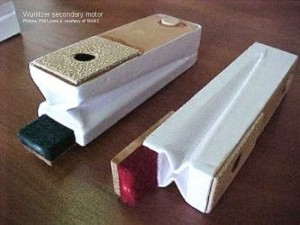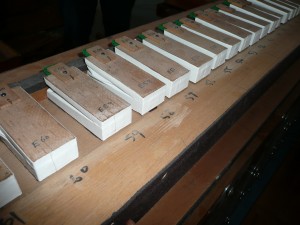Generic term for the small bellows found in the action of an organ, which convert changes in air pressure into mechanical movement or force. They are, therefore, pneumatic actuators.
Frequently constructed of two pieces of wood separated by thin leather, they have a hole on the side which is mounted to the windchest and are attached on the other side to the mechanism (valve, pallet, mallet, contact etc.) they are to actuate. The hole connects to a magnet or valve via a ‘boring’; when the magnet or valve operates and the air pressure inside the motor rises or falls, the motor inflates or deflates thus providing the mechanical actuation.
Motors may be hinged at one end like a fire-bellows (‘book pneumatic’ (Am.)) or parallel.
To maximise the actuating force of external motors, the leather may be stiffened by being glued to card pieces, in which case the motor is said to be ‘ribbed’.
